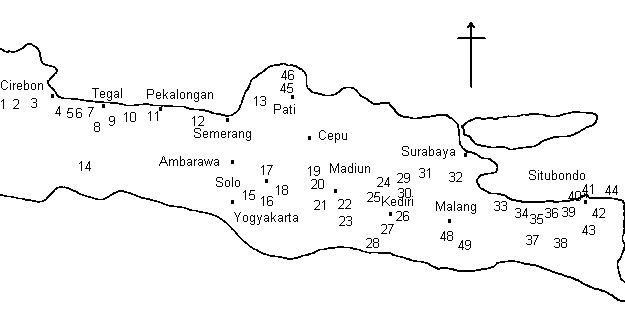|
Steam in Java 1998 |
|||||||||||||||||||||||||||||||||||||||||||||||||||||||||||
|
As many readers of these steam pages will know, I am a regular visitor to Java, this year was my 18th visit and I led my 10th tour. I look upon it as a very public love affair. The devaluation of the Rupiah has meant that visitors work in 'Monopoly Money', before writing one section of this I went out and bought 10 large bottles of Bintang Baru for the equivalent of U$5. Glug..... And, by the way, although I can see changes brought about by the 'crisis', travelling is as easy as ever and the people still as pleasant and friendly as they have ever been. And there are no ordinary tourists! It is difficult to predict just what effect the economic crisis will have on the sugar industry and steam activity in particular. I have been told that annual sugar production is of the order of 2 million tons and consumption 3 million tons! How the country can afford to import this much is unclear, but the local price of sugar has increased somewhat which may suppress demand and encourage production. With the severe economic decline, clearly there will be more trucks available to carry cane, but the cost of the (imported) spare parts for these and the diesel locomotives has risen enormously (400-500%). In theory, the answer is simple - grow more sugar and use steam locomotives out on the line..... In practice, the weather this year has been far too wet and there is tremendous competition for land with rice and even tapioca and there aren't enough good steam locos and lines left anyway. Closing old inefficient marginal mills will also release a number of diesel locomotives. I think the best case scenario is that the rate of attrition which had threatened to accelerate will not actually increase. After all, where else in the world can you find more than 100 narrow gauge steam locomotives at work in 1998? This is the 1998 report, click here for a brief summary of the main news - the proposed mill closures have happened, other reports are available: Click here for the Mill Index or Mill Map or choose the area you want:
The mills are arranged from West to East, North Coast then South Coast with the Private Mills at the end. Click on the mill in the Index below (mills with no link have not used steam in recent years, but may have locos stored on site):

The numbers are those used in the reports. The Main News in Brief Contents
Perumka News Contents Thanks in no small measure to my friend Tjeng Chiao, Ambarawa turned out both E1060 and B2503 for my visiting group on 14th August. We knew the E10 was not operable on the rack owing to incompatibilty problems, but the gods did not smile on us. Firstly, the rack section had been severed one third of the way up by a flash flood a week earlier and secondly, the weather was largely funereal. We had E1060 perform runpasts in the gloom on the flat section between Ambarawa and Jambu and B2503 performed runpasts on the limited open section of the rack. We had both locos out for less than U$200 and in the hope of achieving something better booked the E10 again for the following morning. The light was much better on 15th August. The E10 performed a large number of runpasts at Jambu and on the return journey near Ambarawa with Gunung Merbabu in the background. Cepu Forest Railway Contents Regular logging trains are decidedly irregular and depend on the area being logged, although they are more likely during and immediately after the rainy season when road trucks cannot get into the forest. I hired a private logging train on August 19th for my group and indulged myself by taking it out with 'Bahagia' for myself and one friend earlier on July 30th (just to make sure everything was OK!). As usual staff at Perhutani did their very best to get us the 'master shots' in a day of sunshine and showers. The second charter ran like clockwork with a full set of runpasts in excellent light with 'Augustus'. A superb extra bonus was the steaming of DB 0-6-0T 388/1950 which was probably last active over 20 years ago around 1976. Considering staff had worked on the loco for only 2 weeks before our visit it was amazing that it managed to produce half an hour of runpasts in the log yard before retiring for running repairs. There are virtually no tourists in Java this year (surprise, surprise) and these were the first trains they had run for many months, although a German group visited later in the month. If you want to know how to charter the train, please get in touch. |
|